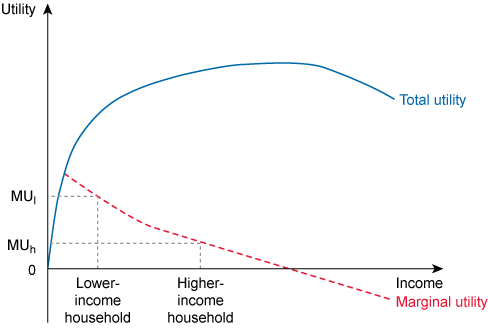3.2 Individual choices
Individuals are assumed to have a goal of maximising utility. However, that does not simply mean consuming as many products as possible.
The utility of a product diminishes the more of the product a consumer has. For example, imagine that you are thirsty and begin to drink glasses of water. The first will quench your thirst and be of great utility to you. The second may also be welcome. But there will be a point where drinking another glass of water is not going to yield much additional benefit. There may even come a point at which an extra glass causes you displeasure (negative utility) if it makes you feel bloated and ill.
This concept of utility declining with the quantity consumed is call the law of diminishing marginal utility. It applies to most goods and services consumed; and it even applies to the income used to buy goods and services, as illustrated in Figure 7.
The horizontal axis in Figure 7 shows total household income, increasing from left to right. The vertical axis measures both marginal utility (MU) and total utility. The lower line traces how the marginal utility of an extra amount of income falls as total household income increases. The upper line traces the total utility that a household gets from its income.
Activity 6 Diminishing marginal utility
a.
a) Total utility is the sum of the utility derived from each unit of a good that is consumed.
b.
b) The extra utility from consuming one more unit is called marginal utility.
c.
c) Every extra unit consumed provides the same amount of utility as every other unit.
d.
d) Each extra unit consumed normally provides less utility than previous units.
e.
e) Total utility falls when marginal utility falls.
f.
f) Total utility rises as long as marginal utility is positive.
g.
g) Total utility always increases the more units a person consumes.
The correct answers are a, b, d and f.
Answer
The correct statements are (a), (b), (d) and (f).
2. Figure 7 shows that a lower income household gets a relatively higher marginal utility (MUl) from an extra sum of income than the marginal utility (MUh) that a higher income household gets. For example, the extra sum of income might be £10 a week. Explain why a household with a total income of £100 a week might get more marginal utility from the extra £10 than a household with a total income of £1,000 a week.
Answer
Low-income households are normally unable to buy all the goods and services they want and derive a high utility from those they can. Better-off households can buy much more, including goods and services in excessive quantities or ones they don’t need so much. So, just as diminishing marginal utility means that an individual derives less satisfaction from each extra unit of a good or service, it can also be assumed that better-off households derive less utility from a unit of a good or service than lower-income households.
As the activity highlights, consumers don’t look at buying a particular good or service in isolation – they are constrained by their income. As a consequence, they must choose how to allocate their budget between multiple goods and services. This creates a trade-off – in order to gain the utility from consuming one product, they must forego others they could have bought instead, in other words there is an opportunity cost.

